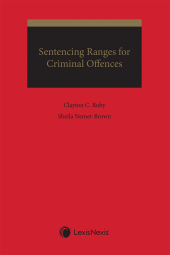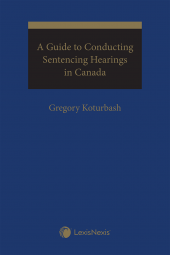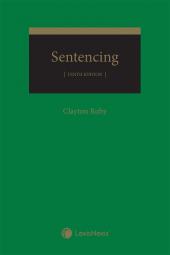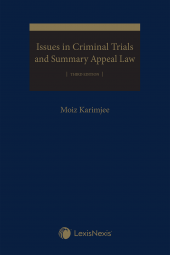Sentencing Ranges for Criminal Offences
One Year Subscription Only Terms
Subscribers receive the product(s) listed on the Order Form and any Updates made available during the annual subscription period. Shipping and handling fees are not included in the annual price.
Subscribers are advised of the number of Updates that were made to the particular publication the prior year. The number of Updates may vary due to developments in the law and other publishing issues, but subscribers may use this as a rough estimate of future shipments. Subscribers may call Customer Support at 800-833-9844 for additional information.
Subscribers may cancel this subscription by: calling Customer Support at 800-833-9844; emailing customer.support@lexisnexis.com; or returning the invoice marked 'CANCEL'.
If subscribers cancel within 30 days after the product is ordered or received and return the product at their expense, then they will receive a full credit of the price for the annual subscription.
If subscribers cancel between 31 and 60 days after the invoice date and return the product at their expense, then they will receive a 5/6th credit of the price for the annual subscription. No credit will be given for cancellations more than 60 days after the invoice date. To receive any credit, subscriber must return all product(s) shipped during the year at their expense within the applicable cancellation period listed above.
Product description
This new title is an abridged version of Clayton Ruby’s highly respected publication, Sentencing, 10th Edition, and particularly Chapter 23, which examines the historical and modern considerations applied in determining ranges of sentence for particular offences. Sentencing ranges reflect the principle of parity, which requires that similar offenders who commit similar offences in similar circumstances should receive similar sentences.
This book will be a quick and easy resource for determining the current ranges for over 40 specific offences under the Criminal Code and the Controlled Drugs and Substances Act (CDSA). For each offence, readers will be able to:
- Find the current range of sentence in each relevant jurisdiction
- Find the offence number and penalty specified under the Criminal Code or the CDSA
- Be alerted to the most important considerations in determining the appropriate range of sentence for the offence, including statutorily mandated considerations
- Find a list of cases listed with the sentence imposed noted for each case
Topics Covered
- Second degree murder, attempted murder, manslaughter
- Discharging a firearm with intent
- Criminal harassment
- Publication of an intimate image without consent
- Uttering threats
- Failure to provide the necessaries of life
- Assault, sexual assault
- Kidnapping, unlawful or forcible confinement, luring
- Human trafficking, abduction or removal of a child from Canada
- Sexual offences against children, incest, child pornography
- Robbery, break and enter, theft, possession of stolen property
- Arson
- Mischief
- Fraud
- Possession and trafficking of cocaine, fentanyl, and other controlled substances
- Plus much more
Who Should Read This Book
- Criminal Defence Lawyers – offers possible sentence ranges, which helps in determining the advice to the client and conduct of the case, preparation for sentencing, and formulating possible avenues for a sentencing appeal
- Judges – assists in determining sentence range and ensuring that sentences are appropriate
- Crown Counsel – helps in formulating appropriate sentencing recommendations
- Law Libraries – an authoritative guide and invaluable research tool on sentencing in Canada
Table of contents
Part I: Introduction
Part II: Offences
Chapter 1: Second Degree Murder
Chapter 2: Attempted Murder
Chapter 3: Manslaughter
Chapter 4: Discharging a Firearm with Intent
Chapter 5: Criminal Harassment
Chapter 6: Publication of an Intimate Image Without Consent
Chapter 7: Uttering Threats
Chapter 8: Failure to Provide the Necessaries of Life
Chapter 9: Assault
Chapter 10: Offences Against Police Officers and Persons Executing Lawful Process
Chapter 11: Kidnapping
Chapter 12: Unlawful or Forcible Confinement
Chapter 13: Human Trafficking
Chapter 14: Abduction or Removal of a Child from Canada
Chapter 15: Sexual Assault – Victim Sixteen or Older
Chapter 16: Sexual Offences Against Children
Chapter 17: Incest
Chapter 18: Luring
Chapter 19: Child Pornography
Chapter 20: Robbery
Chapter 21: Break and Enter
Chapter 22: Theft
Chapter 23: Possession of Stolen Property
Chapter 24: Arson
Chapter 25: Mischief
Chapter 26: Public Mischief
Chapter 27: Use of a Firearm in the Commission of an Offence – Section 85
Chapter 28: Careless Use and Pointing of Firearm – Sections 86 To 88
Chapter 29: Possession of Prohibited and Restricted Weapons – Sections 90 To 96
Chapter 30: Break and Enter or Robbery to Steal Firearm – Sections 98 To 98.1
Chapter 31: Fraud
Chapter 32: Dangerous Operation of a Conveyance
Chapter 33: Operation of a Conveyance While Impaired
Chapter 34: Failure to Comply with a Demand
Chapter 35: Failure to Stop
Chapter 36: Operation of a Conveyance while Prohibited
Chapter 37: Criminal Negligence Causing Death or Bodily Harm
Chapter 38: Controlled Drugs and Substances – Possession
Chapter 39: Trafficking or Possession for the Purpose of Trafficking
Chapter 40: Importation
Chapter 41: Production of Drugs and Substances
 Lexis Nexis
Lexis Nexis 


